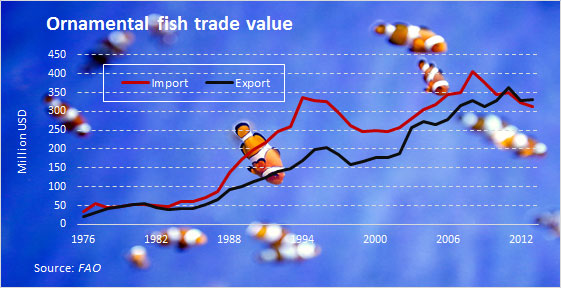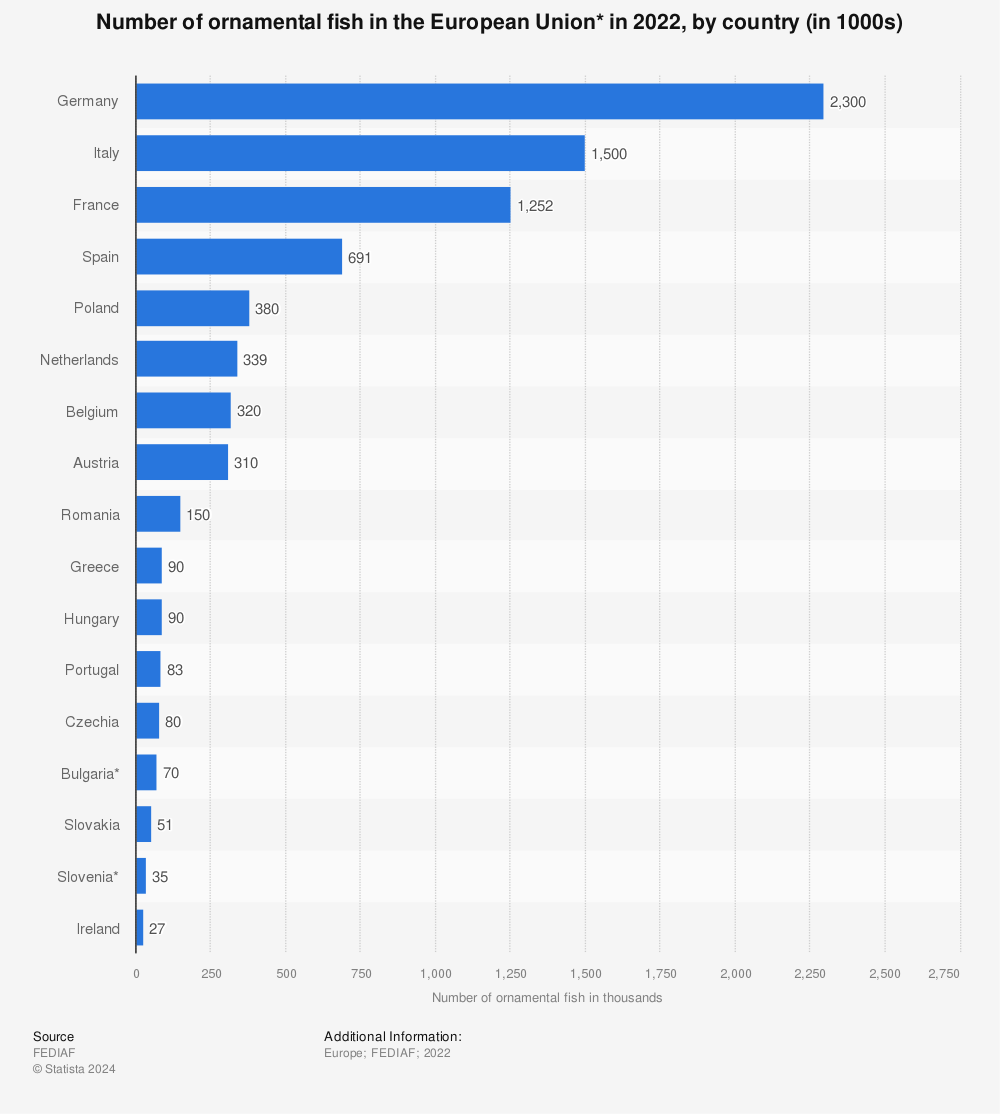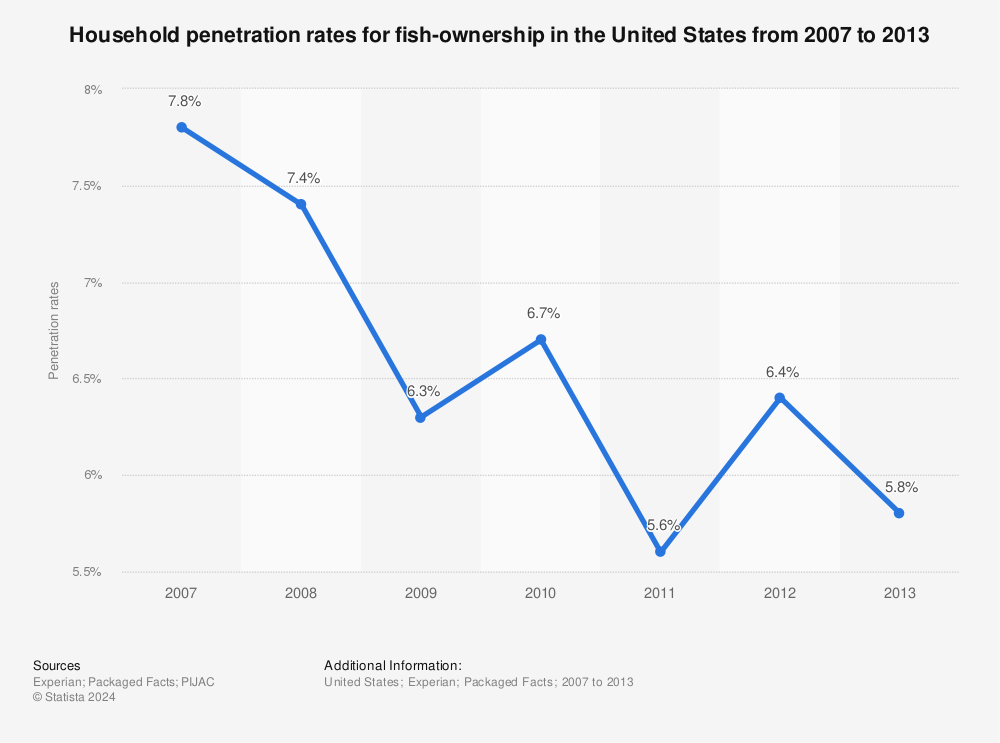In Singapore, the ornamental fish industry still focuses on traditional methods of farming. Sunlight is required, for example, to give the fish an extra level of luster. In the past, these traditions helped to establish an industry that was dominant. Since 1985, the value of international trade in exports have experienced a steady growth rate of 14% each year, with developing countries accounting for more than two-thirds of total export value.
Today, however, the Singapore ornamental fish industry appears to be in a lot of trouble. With higher shipping costs, more competition, and land leases that are set to expire, if farmers don’t meet expected quota levels, this industry could be completely gone by 2021.
Statistics About the Singapore Ornamental Fish Industry
#1. Export values for the Singapore ornamental fish industry in 2016 were listed at $43 million. That equates to a 14.1% market share for the industry. (Channel News Asia)
#2. In 2007, the industry offered exports that were valued at nearly $69 million. At that time, the ornamental fish industry accounted for over 20% of the worldwide market. (Channel News Asia)
#3. Several countries have developed competitive industries to counter Singapore’s dominance in this market. Indonesia, Thailand, and Malaysia all have more labor available to the industry and more space that can be used for farming. (Channel News Asia)
#4. One of the biggest struggles for the ornamental fish industry is transportation infrastructure. The industry ships fish on passenger planes to meet delivery times that are 36 hours or less. (Channel News Asia)
#5. Ornamental fish that spend time packed into tight spaces experience high levels of stress, which impacts the value of each shipment if it takes too long to arrive at its intended destination. (Channel News Asia)
#6. Singapore has 125 ornamental fish farms in operation right now, but most of them are in Sungei Tengah or Lim Chu Kang, which is in the northwestern part of the small island nation. (Channel News Asia / Mothership)
#7. From 2000-2011, the overall global ornamental fish industry grew from $181 million to $372 million. In 2012, Singapore exported $62 million of ornamental fish to more than 80 different countries. (Agri-Food and Veterinary Authority of Singapore)
#8. Despite going from over $80 million in total exports to $43 million in exports in 2016, Singapore continues to be the #1 exporter of ornamental fish to the rest of the world. (Mothership)
#9. The 5 most popular species that are exported by the Singapore ornamental fish industry are guppies, mollies, platys, goldfish, and koi. (Mothership)
#10. More than 90% of freshwater ornamental fish are captive-bred by the industry, compared to just 25 marine breeds that are saltwater ornamental fish. (Singapore Aquarium Fish Exporters Association)
#11. About 3,000mt of coral are traded annually in the ornamental fish industry. (Singapore Aquarium Fish Exporters Association)
#12. The entire ornamental fish industry in Singapore, when retail sales, products, wages, and materials are considered, has an estimated net worth of about $15 billion. (Singapore Aquarium Fish Exporters Association)
#13. The average lifespan of koi that are exported from Singapore is 15-20 years. Pricing for these fish range from $3-$150, depending upon the variety of the fish and its size. (The Straits Times)
#14. The goal of the Singapore ornamental fish industry is to create a one-stop shopping experience for importers. In total, there are about 500 different species of ornamental fish that are available for sale at any given time. (Agrotechno Market)
#15. Local farms account for about 40% of the total sales that exist within the region. Regional farms also purchase from local suppliers at times to fulfill their export obligations. (Agrotechno Market)
#16. On the average year, the Singapore ornamental fish industry exports about 20% of the total number of fish that are sold globally. One firm, Quan Hu Corporation, is believed to account for 5% of total global sales on their own. (BBC)
#17. New industries involving ornamental fish may increase the viability of the industry in coming years. Spa treatments that involve ornamental fish called garra rufa eat dead skin and calluses. (BBC)
#18. The Singapore government has formed enterprise development groups to help save the industry as well. One opportunity, developed by Apollo Aquaculture Group, used a S$300,000 investment to develop new recirculating systems. It allows water to be filtered and reused, reducing wastewater costs by up to 70%. (Channel News Asia)
#19. The gap between Singapore and the next nations that export ornamental fish is continuing to close. In 2007, the difference between Singapore and second place was over $34 million. In 2009, the difference was just $13 million. (FAO)
#20. In the past, Singapore offered the ornamental fish industry 10-year leases for their aquaculture space. Once those leases expired, renewals of two or three years were offered to most farmers. (Asia One)
#21. The organizations that have seen the most success have aggressively targeted the world’s top importers of ornamental fish. The United States accounts for 17% of total imports, with a 2012 value of $13.4 million. The United Kingdom is in second place, accounting for 16% of total imports valued at $12.2 million. Japan, Germany, the Netherlands, and France all have between 5-9% of the import value share individually. (Agri-Food and Veterinary Authority of Singapore)
Here is a great chart from FAO showing the global value of the ornamental fish industry.

Singapore Ornamental Fish Industry Trends and Analysis
There are several challenges that must be met by the Singapore ornamental fish industry for it to be successful in future years. Investments into research and development must occur for the industry to stay competitive. Because of the uncertainty within the industry right now, including the possibility of having land tenders revoked, outside investments will be difficult, if not impossible, to find.
That means it is up to the organizations within this industry to work on saving themselves. By developing new tanks, water circulation methods, and other care techniques that go beyond traditional methods, there could be a chance for success.
To remain competitive, the industry must find ways to account for their limited land resources. They must innovate to counter their limited labor resources. Technology can improve worker productivity, but outside investors will likely be necessary.
Although millions of people visit Brandon's blog each month, his path to success was not easy. Go here to read his incredible story, "From Disabled and $500k in Debt to a Pro Blogger with 5 Million Monthly Visitors." If you want to send Brandon a quick message, then visit his contact page here.


